From prefixes and suffixes to roots, teaching morphology is a great way to expand students’ vocabulary and decoding skills. While there is not a universally recommended or approved scope and sequence for teaching morphology, there are some general guidelines that teachers can use to guide their instruction. This blog post will share a leveled morphology scope and sequence that can serve as a framework for your instruction. Additionally, we will explore some guidelines and tips to keep in mind as you plan out and execute instruction.
To read more about the power of teaching morphology in grades 4-5, click here.
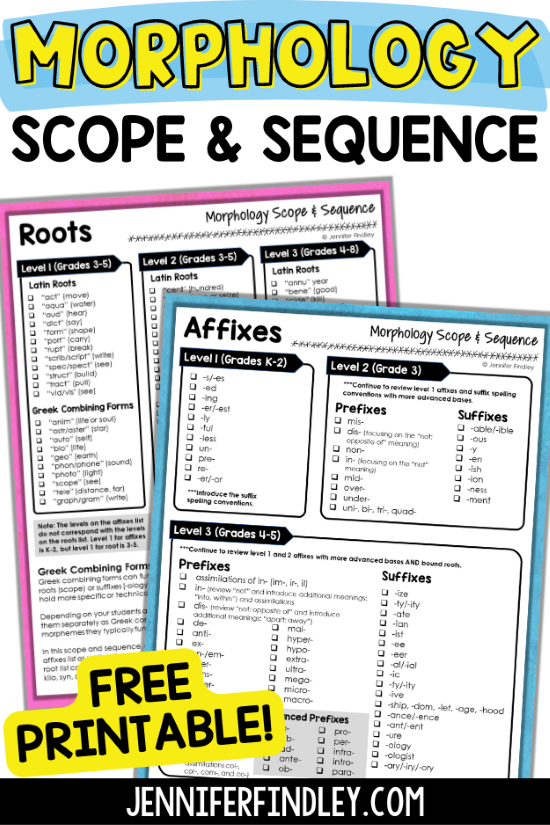
Morphology Scope and Sequence Guidelines
Here are some guidelines that are important to keep in mind when creating your own morphology scope and sequence (and when planning for instruction).
1. Begin with transparent morphemes (versus opaque) where the connection between the morpheme and its meaning is clear and straightforward. For example, the suffix ‘-ness’ in ‘happiness’ directly correlates to the state or quality of being happy. Starting with transparent morphemes can help students grasp the concept of morphemes more easily, as they can clearly see how these word parts add to the overall meaning of the word. As students become more comfortable with transparent morphemes, they can then move on to opaque morphemes, where the relationship between the morpheme and its meaning might be less obvious (usually due to historical language changes and evolution).
2. Use known bases that students know and build on those. For each grade level, use the bases students know and add on a variety of prefixes and suffixes to expand on those bases. For example, students in K-2 might explore words unlike and unhappy, and older students might explore words like unorganized and unimaginable.
3. Morphology instruction should allow for words to be built and deconstructed as soon as possible. After introducing specific morphemes, students should be encouraged to create words using common prefixes, base words, and suffixes. For example, once students learn the prefix “un-“, the base word “happy”, and the suffix “-ness”, they should be able to construct the word “unhappiness” and deconstruct it back to the word sum “un + happy + ness.”
4. Teach more common morphemes before less common morphemes: Common prefixes such as “un-“, “re-“, “in-“, “dis-“, “en-“, “em-“, “non-“, “over-“, and “mis-” and suffixes such as “-er”, “-est”, “-ly”, “-ing”, “-ed”, and “-ness” should be taught before moving on to less common affixes.
5. Include explicit teaching of how morphemes affect word meaning. Understanding that a morpheme carries meaning and changes the meaning of a word when it is added or removed is an important part of morphology. For example, adding the suffix “-less” to “fear” changes the word to “fearless”, which has a very different meaning.
6. Integrate morphology teaching with vocabulary and reading instruction. Applying morphemic analysis during vocabulary and reading lessons can help students understand new words, improve their reading comprehension, and encourage an interest in words. Click here to grab a FREE Prefix Passage with Lessons + Activities for Grades 4-5.
7. Include regular review. Repetition is key to ensuring that students truly grasp the concepts and are able to use them independently. Revisit affixes and bases while introducing new ones. As students progress through the grade levels, review previously taught affixes with more advanced base words and eventually bound roots.
Prefix and Suffix Instruction
Now let’s dive into a suggested leveled scope and sequence for teaching morphology.
Grades K-2 Morphology Scope and Sequence
Morphology instruction begins early in the primary grades with inflectional suffixes. Inflectional suffixes are suffixes that do not change the meaning or part of speech. They simply change verb tense (-ing,-ed, -en), show plurality (-s,-es), indicate possession (‘s, s’), or create comparative/superlative forms (-er,-est).
After inflectional suffixes, the instruction should then move on to the most common and transparent (easily defined) derivational suffixes (suffixes that impact meaning and/or part of speech) and prefixes.
Here are some commonly taught prefixes and suffixes in K-2. These are common because they are easy to define and see the connection between the affix and the base word. They can also be added to several age-appropriate base words.
Students are often also introduced to the big 3 suffix spelling conventions (1:1 Doubling Rule, Silent E, The Y Rule) in 2nd grade.
Once students have been introduced to a handful of prefixes and suffixes, begin implementing a variety of morphology activities such as breaking words down into word sums (un + happy), creating new words with a common base (careful and careless), using multimorphemic words in sentences, and even simple morphology matrixes and word chains.
Note: Students in K-2 are also exposed to morphology with compound words, which is a great way to demonstrate that smaller, meaningful word parts (morphemes) can come together to form a new word.
Grades 3-5 Morphology Scope and Sequence
For grades 3-5, you will want to continue prefix and suffix instruction. You will not only introduce more advanced affixes in these grade levels, but you will also want to continue to review level 1 affixes with more advanced bases and with double-suffixed words (fearfully, carelessly, etc). Also, continue reviewing suffix spelling conventions while reviewing more complex base words and new suffixes.
The order can vary but here is one suggested order of prefix and suffix instruction for this grade level.
When teaching (or reviewing) prefixes, bring in instruction on assimilated prefixes and prefixes with different meanings. Example: dis- is often taught in the younger grades with the meaning not or opposite of but it can also mean apart or away (more commonly seen with roots).
Working with Base Words and Affixes
As soon as students have a strong grasp on a variety of prefixes and suffixes, you will want to start activities that incorporate multiple affixes and bases and show how morphemes can impact the meaning of words. Two great activities for this are word chains and matrixes.
A morphology word chain shows how one word can be transformed into another by adding, removing, or changing a prefix, suffix, or base. For example, one could start with the base word “like”, add the suffix “-ly” to get “likely”, then add the prefix “un-” to get “unlikely”.
Click here to read more about morphology word chains and grab free resources.
A morphology word matrix, on the other hand, is a more comprehensive tool that visually illustrates all possible combinations of a word with different prefixes and suffixes. For example, the base word “help” can be changed by adding various prefixes (un-, dis-) and suffixes (-ful, -less, -er, -ness, -ly) to create a wide array of words like “unhelpful”, “helper”, “unhelpfulness”, “helpless”, “helpfully,” etc.
Click here to read more about morphology word matrix activities and grab free resources.
Greek and Latin Root Instruction
After exploring word chains and matrices with affixes and bases, instruction on Greek and Latin roots is the next focus (don’t be afraid to introduce roots in conjunction with continued affix instruction as well).
When you are introducing roots, ensure you are reviewing and connecting back to the meaning of prefixes and suffixes and how they work with roots to create words. Example: reject – ject means to throw and re means back, so reject means to “throw back” or “refuse to accept.”
As soon as you can, begin word-creating and deconstructing activities with the newly learned roots, such as word chains and matrix activities with roots.
Here is a suggested sequence to begin your Greek and Latin Root Instruction. Note: The levels on the affixes list do not correspond with the levels on the roots list. Level 1 for affixes is K-2, but level 1 for root is 3-5.
Note: Greek combining forms can function as prefixes (micro-), bound roots (scope) or suffixes (-ology). Greek combining forms typically hold more specific or technical meanings than typical affixes. Depending on your students and your preferences, you can teach them separately as Greek combining forms or teach them with the morphemes they typically function as (prefix or suffix). In this scope and sequence, combining forms are included in the affixes list as well as the roots list. These combining forms from the root list can also function as affixes: auto, bio, geo, photo, tele, kilo, syn, arch, dyna, dys, mono, poly.
Printable Morphology Scope and Sequence
Click here or on the image shown to grab a printable morphology scope and sequence.
Need Morphology Activities and Resources?
Want to easily incorporate morphology into your instruction in just minutes? Try morphology warmups! Or check out the activities bundle of my favorite resources for practicing morphology in a variety of ways all year long! Digital and printable versions are included for flexibility.
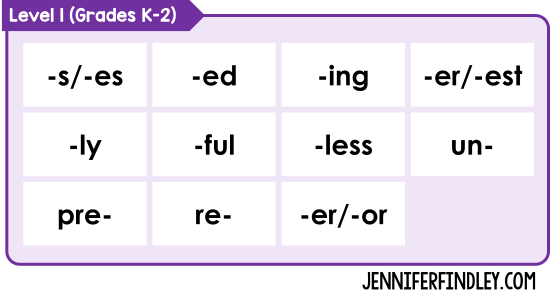
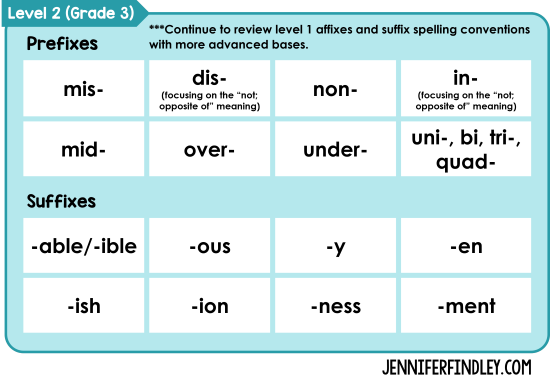
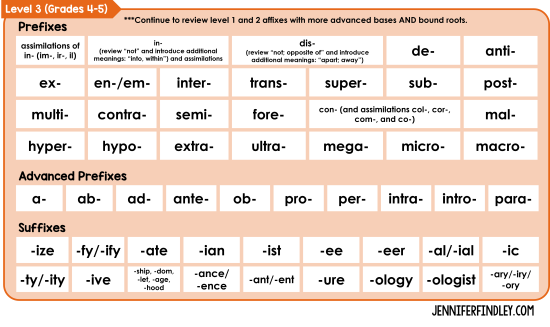
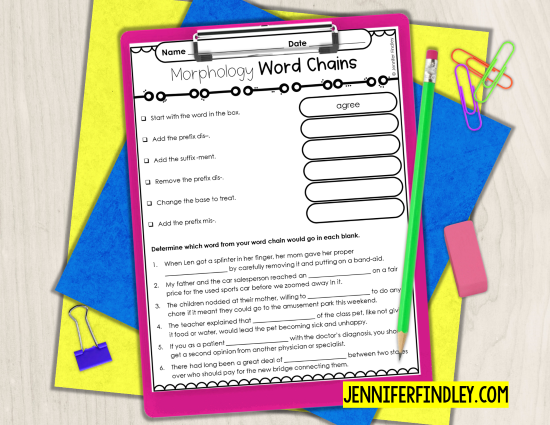
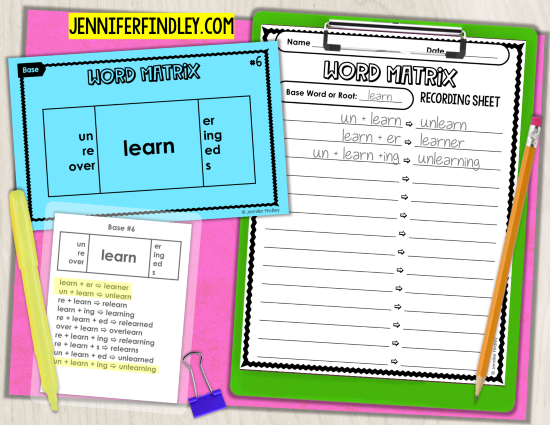
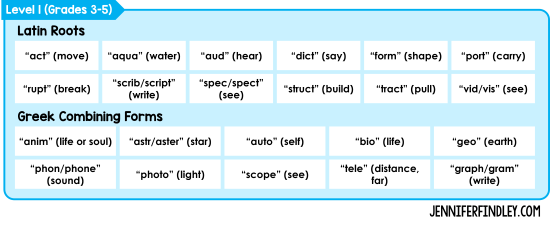
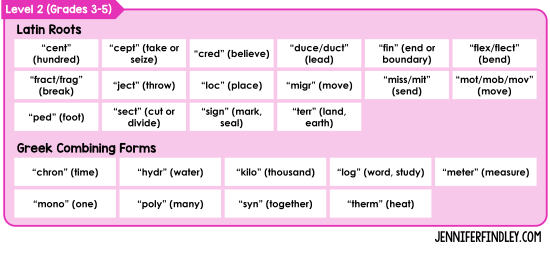
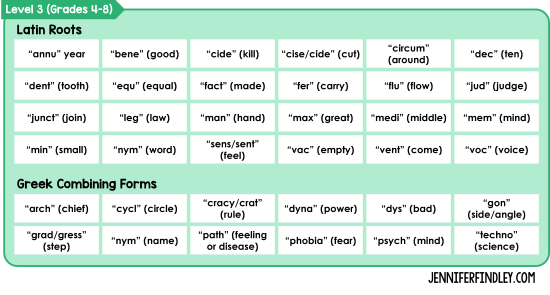










Jennifer,
I notice that you have a wealth of information. Where did you first begin learning about morphemes? Books you studies, etc.?
Hi Jan, here are some of the books that helped me the most:
Backpocket Words: Sharing the Essence of English and Beneath the Surface of Words: What English Spelling Reveals and Why It Matters